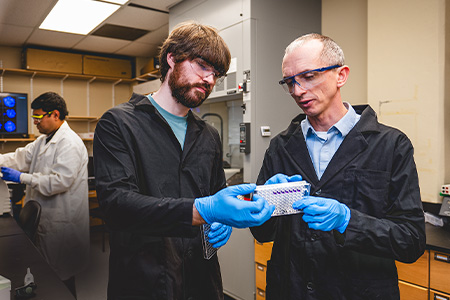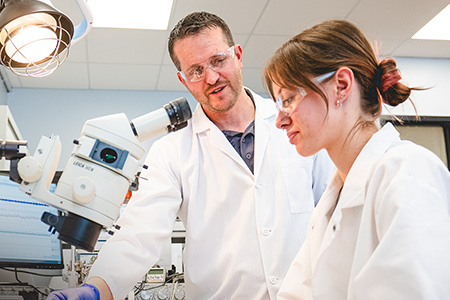Researchers aim to improve human health
Mission possible
By Michelle Geering
While much is known about how the human body functions, plenty of questions remain, especially when the body doesn’t function as it should.
Answering these questions is the mission and passion of researchers at Kansas State University. Continue reading to learn more about some of the health-related research taking place to improve people’s health and quality of life for conditions such as cervical cancer, anxiety, PTSD, heart failure and peripheral artery disease.
Chemotherapy and cervical cancer
The human papillomavirus, or HPV, causes at least 90% of all cervical cancers. While screenings for early detection and licensed vaccines are available, the World Health Organization lists cervical cancer as the fourth leading type of cancer in women globally. This is where Nicholas Wallace, associate professor of biology in the College of Arts and Sciences and assistant director of the Johnson Cancer Research Center, aspires to do good through his research.
“Finding better solutions for cancer patients is what drives us,” Wallace said. “Cervical cancer disproportionally affects those who do not have access to regular medical screenings. In my mind, this should not be happening. Academic institutions are positioned well to drive research forward and leverage the information to do good.”
 Wallace’s research focus is on the role HPV plays in causing cancer. A current project is to better understand how HPV causes cervical cancer and use this information to enhance or improve patient care.
Wallace’s research focus is on the role HPV plays in causing cancer. A current project is to better understand how HPV causes cervical cancer and use this information to enhance or improve patient care.
With funding from the National Institutes of Health, Wallace and his students found that cervical cancer cells use a process called microhomology-mediated end joining to repair DNA. Non-cancerous cells, however, fix DNA damage in other ways. Armed with this knowledge, the lab is examining how to make cancer cells more sensitive to chemotherapy by blocking the cell’s ability to use microhomology-mediated end joining to repair damage.
“The goal is to use a lower dose of chemo, which leads to fewer side effects and better quality of life for cervical cancer patients,” Wallace said. “We want to take the harshness and brutality of chemo away yet keep the chemo working.”
Wallace credits the student and postdoctoral researchers working in his lab for driving this research forward. The students receive hands-on experience working in a biomedical lab and on projects that have the potential to advance to human clinical trials in the future.
Anxiety, PTSD and brain circuits
The brain, which only weighs 3 pounds, is what makes humans human. Different regions of the brain control the body’s processes, including the way we behave and the way we feel, how we make sense of what we see and observe, and our memory.
While small, the brain is a complicated organ and scientists continue to hone their understanding of how each brain region functions and how health care providers should respond when a particular brain region is not responding as it should.
Maria Diehl, assistant professor of psychological sciences in the College of Arts and Sciences, studies the neural circuits in the brain that regulate fear and avoidance behaviors and how social behaviors affect learning to avoid danger. Her research advances understanding the brain circuits that are disrupted in post-traumatic stress disorder and other anxiety disorders.
Sciences, studies the neural circuits in the brain that regulate fear and avoidance behaviors and how social behaviors affect learning to avoid danger. Her research advances understanding the brain circuits that are disrupted in post-traumatic stress disorder and other anxiety disorders.
As part of her work with K-State’s Cognitive and Neurobiological Approaches to Plasticity Center, Diehl studies rat behavior to understand how they may actively avoid danger. Her team trains rats to learn about danger cues in the environment and how to avoid them safely. The scenarios observed model similar behavior patterns in humans with PTSD or anxiety. Rats have similar physiology to humans, including the same brain areas that are important for learning fear and avoiding danger. This helps researchers better understand human anxiety and related disorders.
In her lab, Diehl and student researchers found that female rats are more likely to avoid danger while males display riskier behavior. In a social setting with another rat present, cues are taken from partners to gauge potential danger. Additionally, her research suggests the brain’s anterior cingulate cortex may be key to understanding the neural circuits of avoiding danger under social situations.
“This is basic science research to find the dysfunctional areas of the brain in maladaptive avoidance behaviors,” Diehl said. “The next step will be to rescue those brain functions in hopes of using that as a translatable finding for human treatment of neurological disorders. By learning more about how the brain works and how people become vulnerable to extreme adversities, we can make an important contribution to improved human health.”
Exercise and blood pressure
While daily exercise has many health benefits, exercise can be dangerous for individuals with cardiovascular diseases. Blood pressure naturally increases during exercise, but the blood pressure and heart rate increase with cardiovascular disease is exaggerated, which puts the patients at risk. It can lead to atrial fibrillation, stroke, heart attack or other cardiac issues.
 Steven Copp, associate professor of kinesiology in the College of Health and Human Sciences, studies blood pressure control in heart failure and peripheral artery disease. Copp and undergraduate and graduate student researchers examine how blood pressure and heart rate respond to exercise to better understand cardiovascular function.
Steven Copp, associate professor of kinesiology in the College of Health and Human Sciences, studies blood pressure control in heart failure and peripheral artery disease. Copp and undergraduate and graduate student researchers examine how blood pressure and heart rate respond to exercise to better understand cardiovascular function.
“Our goal is to understand why blood pressure is altered in these patients and by what physiological mechanism,” Copp said. “Eventually, this can lead to a new therapy to help patients perform exercise safely and gain the benefits of physical activity. This will improve quality of life tremendously while reducing the risk of having a cardiovascular event.”
Peripheral artery disease primarily affects the lower limbs and can cause pain when exercising. When skeletal muscles contract, sensory neurons are stimulated and send signals to the brain’s autonomic nervous system, which coordinates the body’s response to exercise, Copp said. In patients with peripheral artery disease, these neurons are hypersensitive, which causes a significantly larger increase in blood pressure and heart rate.
Copp, who directs K-State’s Autonomic Neurophysiology Laboratory, received funding from the National Institutes of Health to better understand how muscle sensory neurons become hypersensitive in cardiovascular disease. The lab found that thromboxane receptors on sensory nerve endings play a role in increasing the activity of the sensory neurons in patients with peripheral artery disease. The identification of this receptor’s role is just the beginning.
“We now continue following the signaling pathway downstream of thromboxane receptors,” Copp said. “The receptor we identified is linked to intracellular signaling pathways that are very complex. We follow the pathway and do experiments at multiple steps along the pathway to see what mechanisms specifically might be playing a role in the exaggerated responses that are being produced during exercise.”